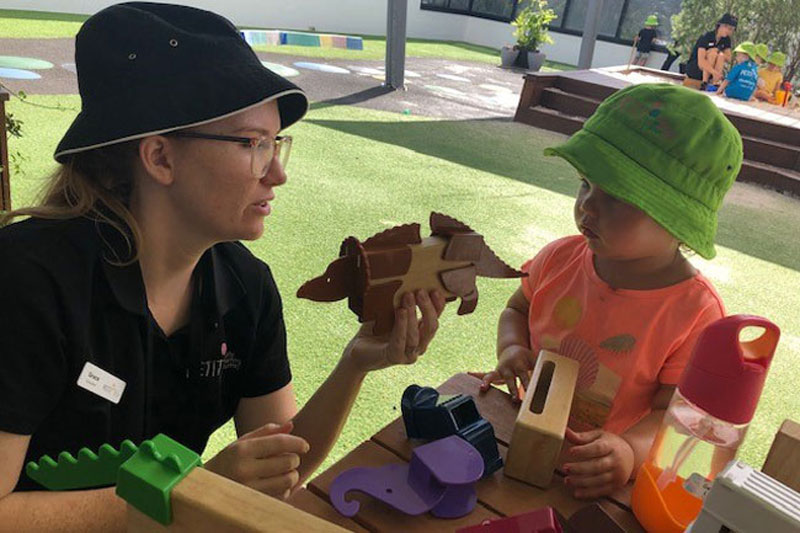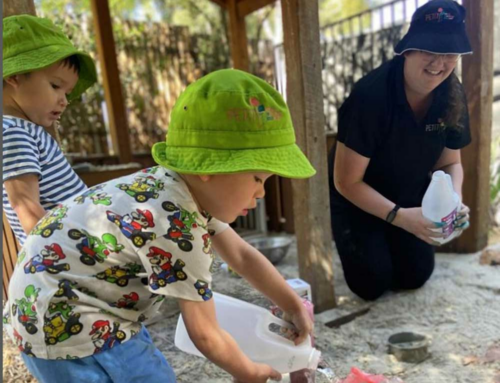The Early Years Learning Framework (EYLF) specifies intentional teaching as one of the eight principles of early childhood pedagogy. When Educators engage in intentional teaching, they support and build on children’s needs, interests, ideas, skills and strengths.
The biggest misconception of intentional teaching is that it relies on traditional classroom learning methods. However, there are more intuitive and thoughtful ways for engaging a child in learning than teaching by rote.
When we create provocations and invitations to investigate, encourage and observe children’s experiences, or nurture their interests and learning through meaningful discussions, the way we interact with children directly impacts their experiences.
This article explores the practice of acting with intentionality and what it means to ensure our actions are “deliberate, purposeful and thoughtful”. We discuss intentional teaching with Petit Early Learning Journey Burleigh on:
- The meaning of intentional teaching.
- Focusing on intentional teaching strategies.
- Observations and examples of intentional teaching from our Educational and Practice leadership team.
- Reflecting on intentional teaching and the EYLF.

What does intentional teaching mean?
The term intentional teaching can sometimes be confusing and have many different meanings and applications depending on who you ask. We feel it is a good practice for Educators to reflect on what it means in relation to the EYLF and to unpack what “deliberate, purposeful and thoughtful” means to them.
“At Petit ELJ Burleigh, we define intentional teaching as purposeful interactions with children that build upon their interests and ideas,” says Shannon Stacey, Centre Support Burleigh.
“We highly value the conversations we have with our families about their children’s interests and family culture. We incorporate the information we learn into our teaching programs in a thoughtful way, as we focus on specific goals and outcomes to support learning.”
“The children’s voices are evident and heard as we begin fabricating our studios’ programs which aligns with our goal of becoming more intentional in our teaching, practices, and interactions.”

Implementing intentional teaching strategies
In 2021, we identified intentional teaching as a SMART goal for our teaching team at Petit ELJ Burleigh. The team implemented several key steps to promote the understanding and practice of acting with intentionality within all studios.
“We have held team meetings to discuss what each of us believes intentional teaching to be,” says Shannon. “We have also reflected on what deliberate teaching, purposeful teaching and thoughtful teaching means and how we can implement different intentional teaching strategies to support children’s learning.”
“With the support of Jenny from the Department of Education, we created our SMART goal for intentional teaching to ensure that it is embedded in our learning outcomes. We have also been working closely with Karen, our Department of Education officer, to align our goal with the departments’ expectations.”
“We have also recently welcomed our new Centre Director, Briony Winters, to our team. Briony brings a wealth of knowledge and experience and values individual learning. We have been working closely to identify and create a vision for the centre and our goals for 2022.”
“Briony will be able to support the team in strengthening their strategies and understanding of intentional teaching through professional developments opportunities, guidance, mentoring, and role modelling.”

Intentional teaching strategies in early childhood education and care
Some strategies for intentional teaching identified by Anne Kennedy in Intentional teaching: Acting thoughtfully, deliberately and purposefully (2014) published by Early Childhood Australia and QKLG: Intentional teaching practices published by the Queensland Curriculum Assessment Authority (2020) include:
Deliberate teaching
- Role modelling desired behaviours.
- Making suggestions to show trust and encourage children’s agency.
- Linking to previous learning.
- Creating provocations, invitations to investigate or play.
- Using open-ended questions.
- Researching and learning with children to investigate an area of interest.
- Using spontaneous teaching and learning moments.
- Showing genuine interest in children’s learning and thinking.
- Scaffolding learning.
- Reflecting with children on their learning experiences.
- Negotiating and helping children develop problem-solving skills and solutions.
- Helping children make connections to prior learning.
- Active listening that encourages children to lead the conversation.
- Instructing when other strategies might not be safe or appropriate.
Purposeful teaching
- Preparing written plans in consultation with families, children and Educators.
- Making shared decisions with families and children about what children need to know.
- Supporting children’s learning with a wide range of experiences to recognise the different ways children learn, their diverse abilities and skills.
Thoughtful teaching
- Creating educational programs and individual plans by critically reflecting on practice and pedagogy.
- Developing partnerships with families to collaborate, discuss and revise the curriculum.
- Reflecting deeply and regularly as individuals and teams on teaching, learning and pedagogy.

Intentional teaching examples
As part of our focus on intentional teaching, Tanya Burr Petit ELJ’s Education & Practice Advisor visited Petit ELJ Burleigh in October 2021 to review and provide specific observations and recommendations.
The following examples from Tanya’s report show what intentional teaching might look like in our services:
“I saw some beautiful examples of intentional teaching whilst spending time in different studios today.
- First, Emma in the Burrows Lane studio, being attuned and responsive to a child when they became upset after another Educator (and close attachment figure) said goodbye and moved to another studio. Emma sat close to the child and reassured him with both verbal and non-verbal cues that he was safe and acknowledged that it was okay to feel sad at missing Jenny. It was beautiful to witness how calm and responsive Emma was, and her understanding in how to meet this child’s emotional needs. Emma was considered and purposeful in her actions.
- The other example I observed was in the Blossom Hill studio later in the morning. Laurie had gathered the children in a circle on the mat and initiated a discussion. She began by commenting that she had noticed when the group was playing outside earlier that some children seemed a bit nervous in joining in play with others and asked the group for ideas on things we could say or do to help our friends join in our play. This began an open free-flowing conversation amongst Laurie and the children sharing different ideas. For me, as an observer, it felt so authentic and respectful of children’s contribution to their own learning, and I could see Laurie’s deliberate intentions as a teacher in facilitating and guiding this experience.”
Tanya also identified areas for improving intentional teaching during her visit, including mealtimes:
“I feel this could be an area for Educators to recognise the power of these times of day for intentional teaching practice, and as a meaningful time to slow down and connect with children. One way to focus attention here would be for all studio teams to finish their ‘visible rituals’ project they began earlier in the year and develop a poster on mealtimes.”
“This will help Educators to reflect on their practices here and recognise and embed more responsive and intentional rituals i.e. one of the studio statements could be:
During mealtimes, Educators sit with children and engage in small group conversations, and sometimes Educators also eat alongside children.”
“This ritual practice not only supports children’s emotional safety and social learning but here Educators are also role modelling social and cultural behaviours for children at mealtimes – a key intentional teaching moment!”
.jpg)
Reflecting on intentional teaching and the EYLF
“We recently engaged in training with Tanya,” says Shannon. “Although this training was focused on the Educational Program, we had an opportunity to discuss ideas around intentional teaching and how we can include each child.”
“We have identified that it can be difficult to capture all children’s ideas and voices, but through brainstorming, the team came up with creative ways that individual children’s interests and needs can be included and captured throughout the day.”
“Briony has also introduced weekly emails to the team in which she invites us to reflect critically upon practices within the service. These moments of reflection allow the team to respond with how they view their own interactions, beliefs, and principles.”
“We are then able to use these responses to support any identified areas of improvement and highlight strengths within the team.”
Intentional teaching means understanding why we teach certain things and how the way we do it impacts children’s learning.
By critically reflecting on our practices, the reasons behind what we do and how we do it, we can identify ways to improve our approach and deepen our understanding of intentional teaching, ultimately leading to better outcomes for our children and their families.

Join our Petit Early Learning Journey family
Are you seeking a career in early childhood education and care where you are inspired and celebrated for embracing learning? At Petit ELJ, our teams work collaboratively with a shared approach to pedagogy.
Our commitment to continuous improvement, learning, and professional development gives you the space to become your best self. We offer mentoring, leadership programs, and fun team-building experiences where you can thrive and feel at home.
If you are a reflective self-learner and a leader willing to share your professional knowledge and experience with others, we’d love to hear from you.






